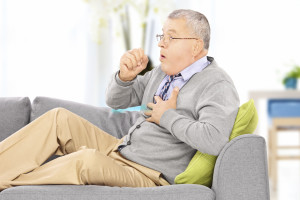The Signs & Symptoms of Lung Cancer
 During the earliest stages of lung cancer, there usually aren’t any noticeable symptoms. These indications only start to manifest once the disease has progressed, which is why this disease is so deadly. One should also understand that many of the symptoms lung cancer patients exhibit are shared with other respiratory diseases such as chronic obstructive pulmonary disease (COPD). If you or a loved one experiences any of the following symptoms, then please be sure to schedule a complete medical evaluation immediately.
During the earliest stages of lung cancer, there usually aren’t any noticeable symptoms. These indications only start to manifest once the disease has progressed, which is why this disease is so deadly. One should also understand that many of the symptoms lung cancer patients exhibit are shared with other respiratory diseases such as chronic obstructive pulmonary disease (COPD). If you or a loved one experiences any of the following symptoms, then please be sure to schedule a complete medical evaluation immediately.
(Have you ever considered participating in a clinical trial? Click here to find a lung cancer clinical trial near you.)
Chronic Cough
Humans cough as a way to expel various irritants or other invasive substances from the airway and throat. An intense cough that persists or becomes steadily worse can be a warning sign for lung cancer and should be inspected by a doctor. Coughing up any blood or bloody mucus is a severe sign that requires immediate medical attention.
Shortness of Breath
This condition, also known as dyspnea, has been described as a tight or even crushing feeling in the chest. As cancerous cells start to proliferate through the lungs, this can create blockages in major airways. This can lead to a buildup of fluids and even mucus around these blockages which causes the shortness of breath in patients.
Wheezing
If you have never experienced wheezing, it is sort of like a high-pitched whistling that emits from the throat as you are breathing out. This sound is produced by a constricted air passages, which in some cases is being caused by a tumor.
Change in Voice or Hoarseness
The vocal cords normally create sound by opening and closing, which produces vibrations. When lung cancer spreads to the throat, it can cause the the vocal cords to become irritated and inflamed. This can cause a person’s voice to change and become more hoarse.
Chronic Fatigue
Everyone who has gotten a bad night’s sleep knows what fatigue feels like. However, chronic fatigue takes that to a whole new level. The presence of cancer means that the body is under attack at all times. The immune system must work constantly to try and quell this invader and that monumental effort will strip the body of most it’s energy.
Fever
The development of a fever means that something wrong is happening inside the body. The presence of an illness can cause the body’s temperature to rise above its normal 98.6 degrees. It’s a reaction designed to keep the body warm while it fights off infection. A fever that doesn’t break after a few days or rises above 101 degrees requires medical attention.
Swelling (Edema)
The body has many of these tiny blood vessels called capillaries, which will leak fluid if put under too much pressure or are damaged. The kidneys will then begin to retain water and salt to compensate for this fluid loss. The excess fluid only causes more leakage from the capillaries, which the lymph nodes must then work to clear from the body. Lung cancer can damage or destroy the lymph nodes which means they won’t be able to clear these fluids from the body. This can lead to swelling in the face, arms and neck.
Less Common Lung Cancer Symptoms
The following symptoms are less common, but could be caused by lung cancer:
- Chronic chest pain
- Pain in the shoulders or back
- Loss of appetite
- Recurring lung infections (such as bronchitis and pneumonia)
- Unexpected weight loss (could be caused by a wide range of cancers)
- Headaches
The following symptoms could indicate that the cancer has begun to metastasize or spread to other parts of the body:
- Memory loss
- Bone and joint pain
- Seizures or otherwise unusual spells of dizziness
- Blood clots
- Yellowing of the skin and eyes (jaundice)
- Numbness or odd feeling of weakness in the arms and legs
- Lumps that appear near the surface of the skin or around the lymph nodes
As you can see, there are many symptoms which could be caused by lung cancer or some other disease. The important thing is that you have an idea of what to look out for and that you schedule an appointment right away if any of these occur. Routine medical screenings are also advised for adults older than 55 who have about a 30 pack-year history of smoking.